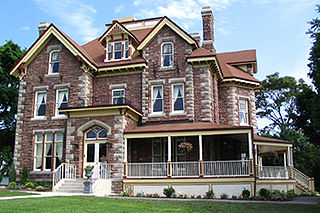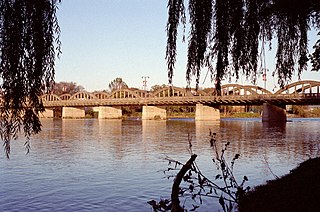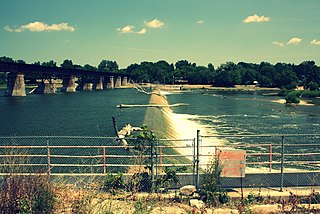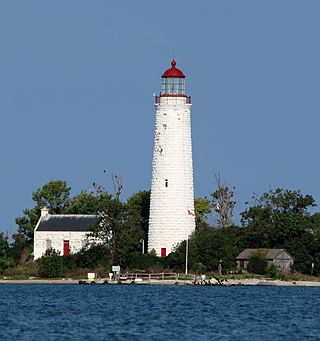
Woodstock is a city in Southwestern Ontario, Canada. The city has a population of 46,705 according to the 2016 Canadian census. Woodstock is the seat of Oxford County, at the head of the Thames River, approximately 128 km from Toronto, and 43 km from London, Ontario. The city is known as the Dairy Capital of Canada and promotes itself as "The Friendly City".

Thorold is a city in Ontario, Canada, located on the Niagara Escarpment. It is also the seat of the Regional Municipality of Niagara. The Welland Canal passes through the city, featuring lock 7 and the Twin Flight Locks.

Coboconk, often shortened to Coby, is a community in the city of Kawartha Lakes, in the south-central portion of the Canadian province of Ontario. The village lies at the junction of Highway 35 and former Highway 48, on the northern tip of Balsam Lake, the highest point on the Trent–Severn Waterway. Coboconk has a prominent role in the logging, limestone, and tourism industries of the Kawartha Lakes region over the past 150 years.

Caledonia is a community located on the Grand River in Haldimand County, Ontario, Canada. It had a population of 12,179 as of the 2021 Canadian Census. Caledonia is within Ward 3 of Haldimand County. The Councillor elected for Ward 3 is Dan Lawrence. As of 2021, there were 4,310 private dwellings in Caledonia.

Haldimand County is a rural city-status single-tier municipality on the Niagara Peninsula in Southern Ontario, Canada, on the north shore of Lake Erie, and on the Grand River. Despite its name, it is no longer a county by definition, as all municipal services are handled by a single level of government. Municipal offices are located in Cayuga.

Greenlaw is a town and civil parish situated in the foothills of the Lammermuir Hills on Blackadder Water at the junction of the A697 and the A6105 in the Scottish Borders area of Scotland. At the 2001 census, the parish had a population of 661.

Cayuga is an unincorporated community and county seat of Haldimand County, Ontario, Canada located at the intersection of Highway 3 and Munsee Street and along the Grand River. Cayuga is about a 20-minute drive from Lake Erie and 30 minutes south of Hamilton and 115 minutes south of Toronto and consequently it has some cottages and recreational properties in the area. In the past, there was some light industry. It has the local district detachment for the Ontario Provincial Police. It is also uniquely located among larger communities on both the American and Canadian sides of the border boasting television reception from Toronto, Buffalo, New York, Hamilton, Kitchener and Erie, Pennsylvania.

The Caledonia Bridge, also known as the Grand River Bridge is a road bridge located in Caledonia, Ontario, Canada on Argyle Street. The bridge is the only nine-span bridge of its kind in Canada and is considered the first reinforced concrete bridge of its type ever built.

Caledonia railway station was built in 1908 by the Grand Trunk Railway Company of Canada. The station was the third to be built in Caledonia, Ontario.

The Township of Alnwick/Haldimand is a township in central Ontario, Canada, in Northumberland County, situated between Lake Ontario and Rice Lake. It was formed in 2001 by the merger of Alnwick Township in the north and Haldimand Township in the south. Alderville First Nation is an autonomously governed First Nation contained within the township boundaries, in two non-contiguous sections along County Roads 45 and 18.
The Haldimand County Heritage Centre is located within the Cayuga Library and Heritage Centre at 19 Talbot St. W in Cayuga, Ontario. The Haldimand County Heritage Centre is a museum that preserves and makes accessible evidence of the history of Haldimand County including genealogy records, local newspapers, maps, census information and more. Artifacts related to Haldimand County are restored and displayed in the museum galleries and grounds. The current curator is Karen Richardson.

The Caledonia Dam, also known as the Grand River Dam, is a dam on the Grand River constructed upstream from the Caledonia Bridge in Caledonia, Ontario, Canada.

Leeds Town Hall is a 19th-century municipal building on The Headrow, Leeds, West Yorkshire, England. Planned to include law courts, a council chamber, offices, a public hall, and a suite of ceremonial rooms, it was built between 1853 and 1858 to a design by the architect Cuthbert Brodrick. With the building of the Civic Hall in 1933, some of these functions were relocated, and after the construction of the Leeds Combined Court Centre in 1993, the Town Hall now serves mainly as a concert, conference and wedding venue, its offices still used by some council departments. It was designated a Grade I listed building in 1951.

Haldimand House is an historic building in Caledonia, Ontario that is one of the oldest in the town. At the time of its construction it was the first in Haldimand County to receive a hotel license and was also the first commercial building in Haldimand County.

The Memorial Hall in Albert Square, Manchester, England, was constructed in 1863–1866 by Thomas Worthington. It was built to commemorate the bicentennial anniversary of the 1662 Act of Uniformity. One of the best examples of Venetian Gothic revival in the city, the hall is a Grade II* listed building.

Old Ipswich Town Hall is a heritage-listed former town hall at 116 Brisbane Street, Ipswich, City of Ipswich, Queensland, Australia. It was designed by James Percy Owen Cowlishaw and built from 1861 to 1879. It is also known as Mechanics School of Arts and the School of Arts. It was added to the Queensland Heritage Register on 21 October 1992.

Toowoomba Police Station Complex is a heritage-listed police station at 50-52 Neil Street, Toowoomba, Queensland, Australia. It was designed by Raymond Clare Nowland and built in 1935. It was added to the Queensland Heritage Register on 5 October 1998.

The Chantry Island Lighthouse, officially known as Chantry Island Lightstation Tower, is a lightstation on Chantry Island, off the coast of Southampton, Ontario in Lake Huron. It was constructed in the years 1855 through to 1859, by John Brown of Thorold, Ontario, under the authority of the Province of Canada and is recognized as one of the six Imperial Towers. Virtually identical, they were completed in 1858-1859 on Lake Huron and Georgian Bay and are among the few lighthouses on the Great Lakes made of cut limestone and granite.

Stratford City Hall is the city hall of Stratford, Ontario, and a National Historic Site of Canada. It sits amidst the city's business district, on a triangular town square.
The Wilson MacDonald Memorial School Museum (WMMSM) is a museum dedicated to preserving the history of rural education in Haldimand County and Canada at large, the heritage of the surrounding community, and the memory of its namesake, Wilson Pugsley MacDonald.

















